What is a scotch yoke valve actuator? Scotch yoke valve actuators are 90˚ driving mechanisms that can be powered by compressed air or hydraulic oil from an external source.
Why consider a Scotch yoke valve actuator?
Deciding which actuator is best for a certain application depends on several factors like environment, required accuracy, and close/open speed. A scotch yoke valve actuator is engineered to automate all types of quarter-turn valves (butterfly, ball, plug, and damper) with various torque profiles to provide a “best fit” for every application. When choosing between a 90˚ actuator such as a Rack & Pinion or Scotch Yoke, the main difference between these actuators are the torques they can generate. The following table shows the difference between the two main types of 90˚ actuators:
[wptb id=25052]
How do they work?
A scotch yoke actuator typically consists of a crank and piston system in a hollow cylinder. Pressure is applied to a side of the piston inside the cylinder. As a result, force is generated which moves the piston along the axis of the cylinder to rotate the actuator stem 90° with pilot air application. When the pressure is relieved, the piston then returns to its original position by a spring.
What valve types does a scotch yoke actuator work with?
A scotch-yoke actuator is only suitable with 90˚rotation valves like butterfly and ball valves and ideal for variable torque valves.
Torque required to operate a valve
The operating torque of a valve is not constant along the stroke. A valve usually requires a higher torque on the start and the end of its stroke.
For a butterfly valve to start opening from a completely closed position, higher torque is required to overcome the friction between the seat and valve body. Lower torques are needed to keep the valve moving in the middle section of the valve stroke.
The torque output of a scotch-yoke actuator changes as a function of stroke position, resulting in higher torque at the beginning and end of the stroke (fig 4).
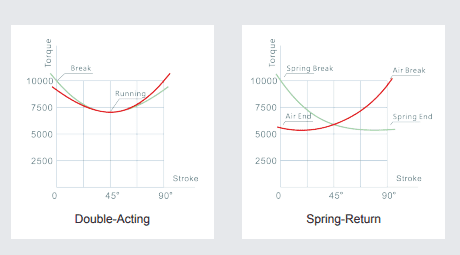
(fig4)
How to select a scotch yoke actuator and size it for a certain valve?
Selection and sizing of a scotch yoke actuator depends on two main values of torque, the following table shows torque values are needed:
[wptb id=25059]
Note that valves of the same type, identical Part Number and size can have different torque values due to sealing type and materials.
For example, if we have a valve with 44,000 inch-Lbs of start-end torque and 25,000 inch-Lbs running torque, a typical scotch-yoke product selection manual would have a torque rating with required pressure tables as shown below.
When reviewing the table, a min available plant air pressure of 60 psi-g would require an actuator such as the CSY25-350. Now we know which model is fit for the valve and pressure required to operate the actuator.
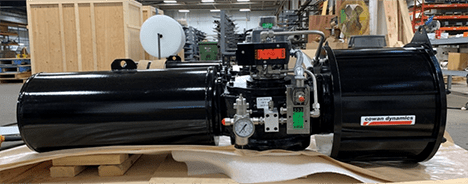
Scotch & Yoke Pneumatic Actuator – Cowan series CSY, complete with controls
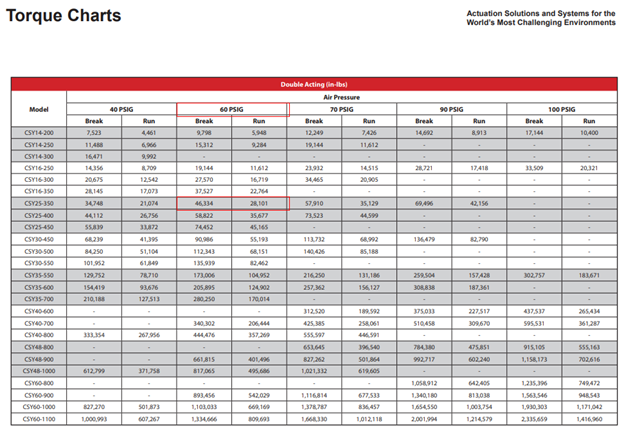
How to calculate the required volume of air to stroke an actuator?
Now that we have sized the actuator, we need to determine the amount of air that is needed to drive the valve for one full stroke. Stroke volumes are shown in the table below (fig6).
Based on the selected model number, we know that we have a “CSY” a “25” module size and a “350” cylinder size. With this information we can determine the volume of air displaced by the actuator:
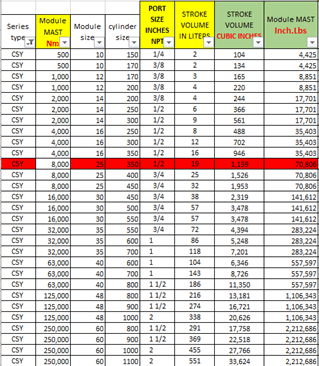
(fig6)
- -air volume closed = 1,159 in3
- -inlet size= ½””
- Therefore, the max volume of air needed to move the actuator a full stroke = air volume closed = 1,159 in3
With the volume of air required to stroke the valve and the needed time to stroke the valve, we can later calculate the required flow coefficient for the accessories and the air consumption.
Applications for a scotch-yoke valve actuator in the industry
- Oil & Gas: actuate valves for isolating flow in pipes
- Mining: actuate valves for isolating nozzles in rocks washing lines
- Water and wastewater: actuate valves for isolating feed lines, filters and tanks
Internal parts and common malfunctions
Usually, malfunctions in scotch-yoke actuators occur due to two main problems:
- Loss of power due to pressure loss
- Wear due to lack of lubrication
- Contamination in the air supply system


